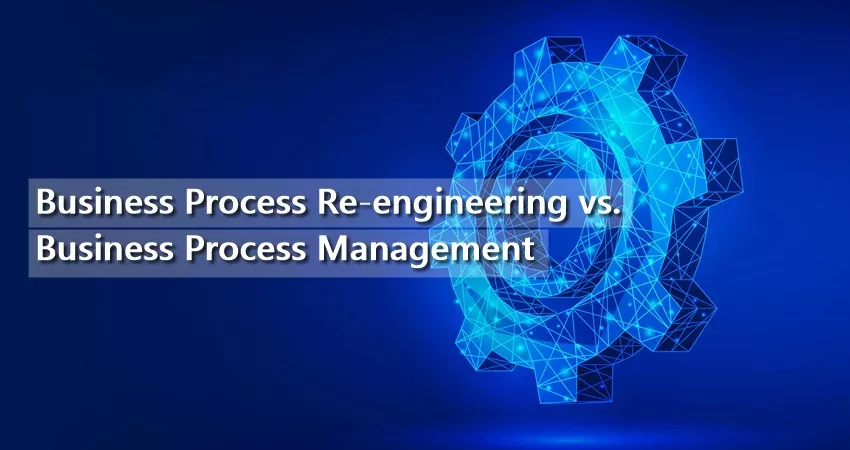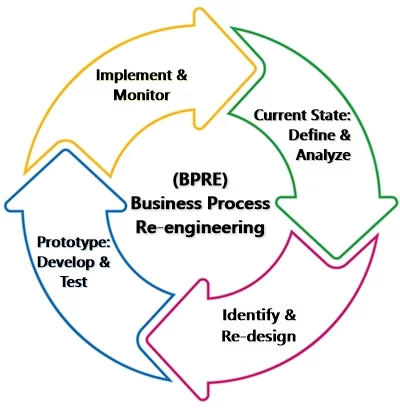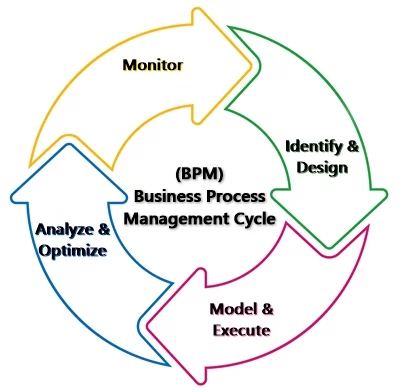Business Process Re-engineering (BPR/BPRE)
Business Process Re-engineering or BPRE is a business management strategy of conducting a business process reconstruction for the sake of uplifting its – product of service quality and lowering the long-term expenditure.
It’s a business strategy that needs business and workflow analysis to discern and draw out the process redundancies.
- Define & analyze the current state.
- Identify & re-design.
- Develop & test the prototype.
- Implement & monitor.
Business Process Management (BPM)
BPM or Business Process Management is strategizing the supervision and maintenance of the workflow to gear up the existing business processes and organization altogether.
BPM is a regular and long-term string of procedures, which serves as the backbone for all business processes in the enterprise.
Consistently managing and improving the overall company business process by the below processes:
- Identify & Design
- Model & Execute
- Analyze & Optimize
- Monitor
Both BPR and BPM undergo several steps for better productivity of the processes.
They go through some similar business processes like understanding the existing methods, identification, evaluation, and analysis.
The main goals in BPR and BPM, are improving the speed and quality of the business processes.
Both processes work at reducing expenses while smoothly carrying out the workflow in the organization.
Despite the above-listed similarities, their core functionality varies massively. Sure, in a way, BPR can be seen as a distinguished part, or a follow-up on BPM.
However, the BPR strategy aims at the efficiency and productivity of a particular process/step in the workflow. At the same time, BPM is a long-term strategy that concerns the entire workflow management.
Business Process Re-engineering (BPR) and Business Process Management (BPM) should be in no way called similar or viewed as alternatives to one another.
Also Read: Digital/Business Process Automation DPA/BPA Explained in Detail
Business Process Re-engineering (BPR) |
Business Process Management (BPM) |
| Reconstructs a process flow with a new approach. | Works on monitoring and maintaining the current state. |
| Discerns and draws out any redundant processes. | Does not reject any process in the business flow. |
| A cross-functional, more strategical approach. | A disciplined managerial approach. |
| Improves operational efficiency by designing the future state process. Recreating a procedure is the primary intent of BPR. | BPM does not redesign and recreate any of the business procedures in an organizational workflow. |
| Works over the processes individually. The goal is to find a better approach with better output. | Operates over a set of business processes simultaneously, with a consistent approach. |
| Any collaboration is circumstantial. | Aligns and works altogether on HR and IT resources more effectively. |
| A reiteration is never an option. If a process undergoes BPR redesign, changes occur from the first stage of development. | Reiterates conventional methods and procedures while relying heavily upon different automation tools. |
| Analyzes and views an operation from different and wider angles. | No new operational view is adopted in a method. |
| Comparatively higher expenses, as it focuses on minimizing the long-term expenditure rate. | Lesser expenses. |
| BPR strategies transcend organizational boundaries. | No new amendments occur in an organization’s culture via business process management. |
BPM is the Backbone for the Business Workflow
Business process management helps you run a faster and smoother workflow while disciplinarily managing and analyzing all the automated and non-automated business strategies.
BPM is a general business practice. It shares the organization’s concerns over streamlining business processes, orchestration, monitoring the complex systems, and so forth.
BPM strategy only deals with the laid out process flow, and act under the given set of management techniques. Automation thus holds a strong significance over BPM.
Business process automation is an upgraded, digitized, and automated form of traditional BPM. BPM has since integrated with multiple new technologies to meet current business necessities.
With business process automation or Digital Process Automation (DPA), the process done by traditional BPM has evolved with digital transformation and focuses more on enhancing customer experience.
BPR/BPRE is Crucial for Running any Business
Automation is an attractive technology for a fixed portion of an operation. However, one major challenge that a manager encounters is concentrating on obliterating redundant processes, instead of automating it.
Some managers go on using way too many automation tools and techniques in the name of BPM and end up wasting time and other resources over wrong issues.
In that situation, most of the operations automated in the company workflow, start producing negative output consequently.
Concern less upon how to manage a regular task, and focus on examining and obliterating the redundant and time-consuming processes. It is imperative to work in the reconstruction or removal of that inessential process entirely.
Also Read: What are the Challenges to Implement Business Process Reengineering?



